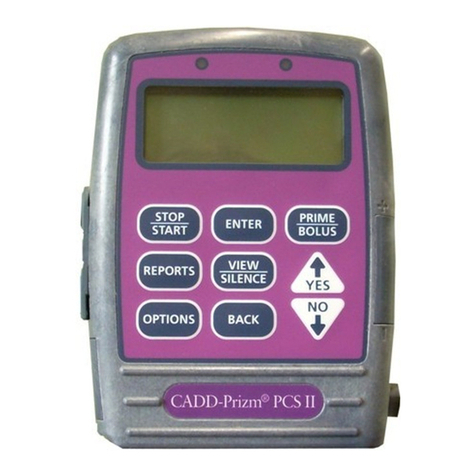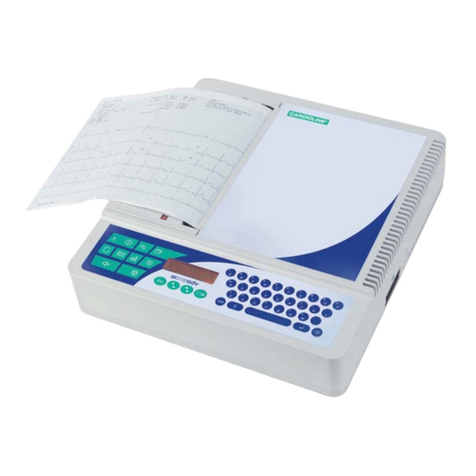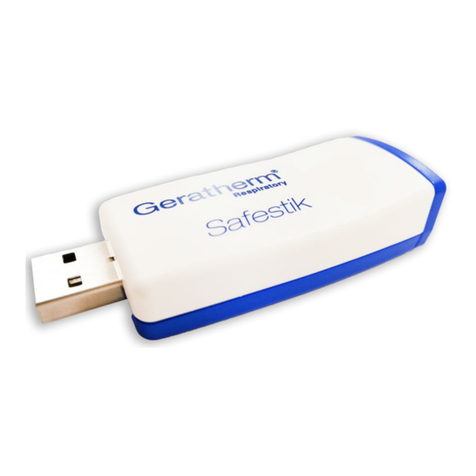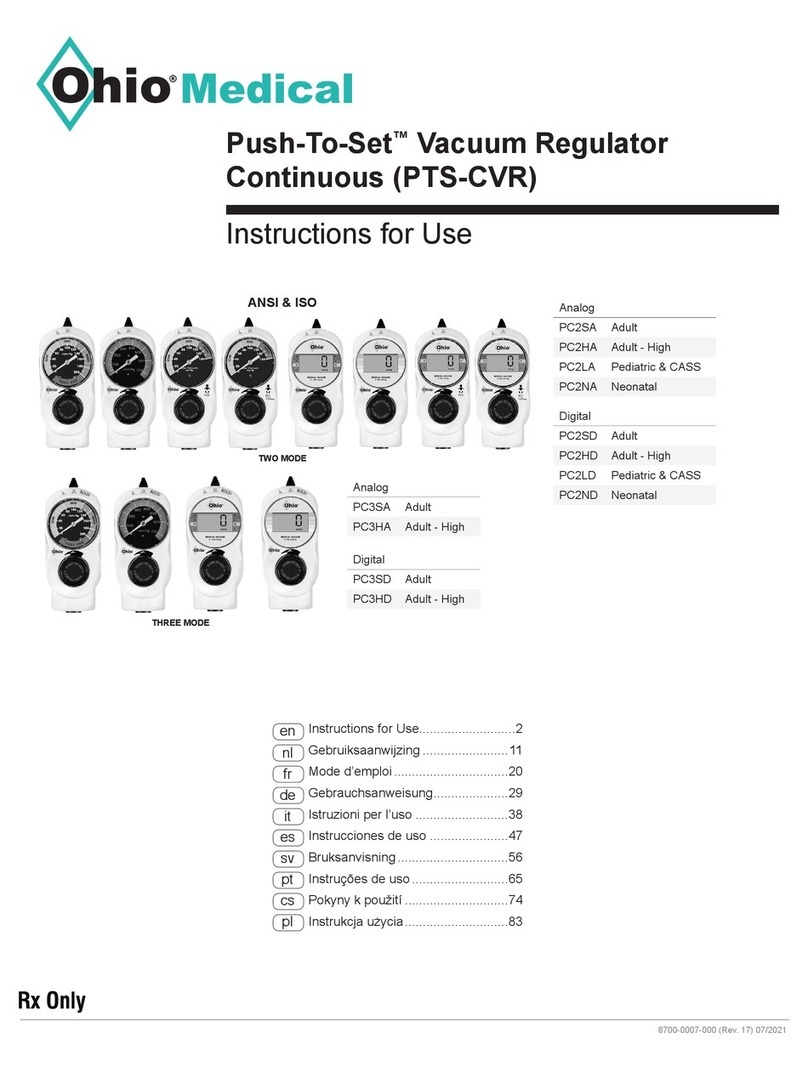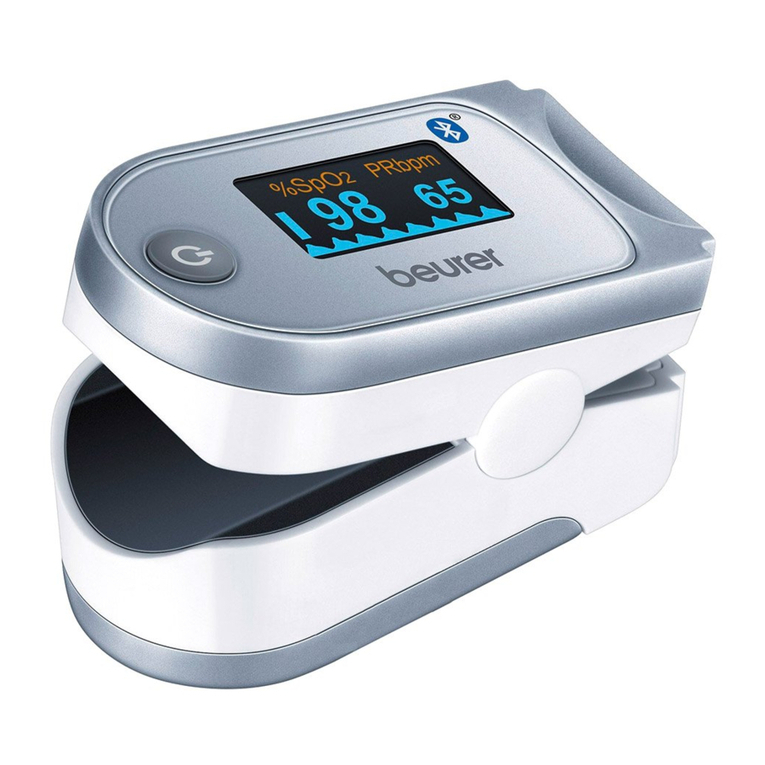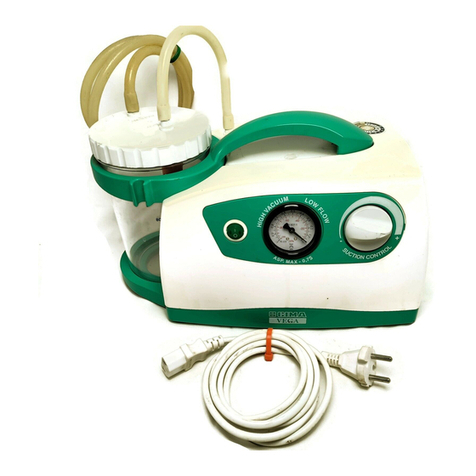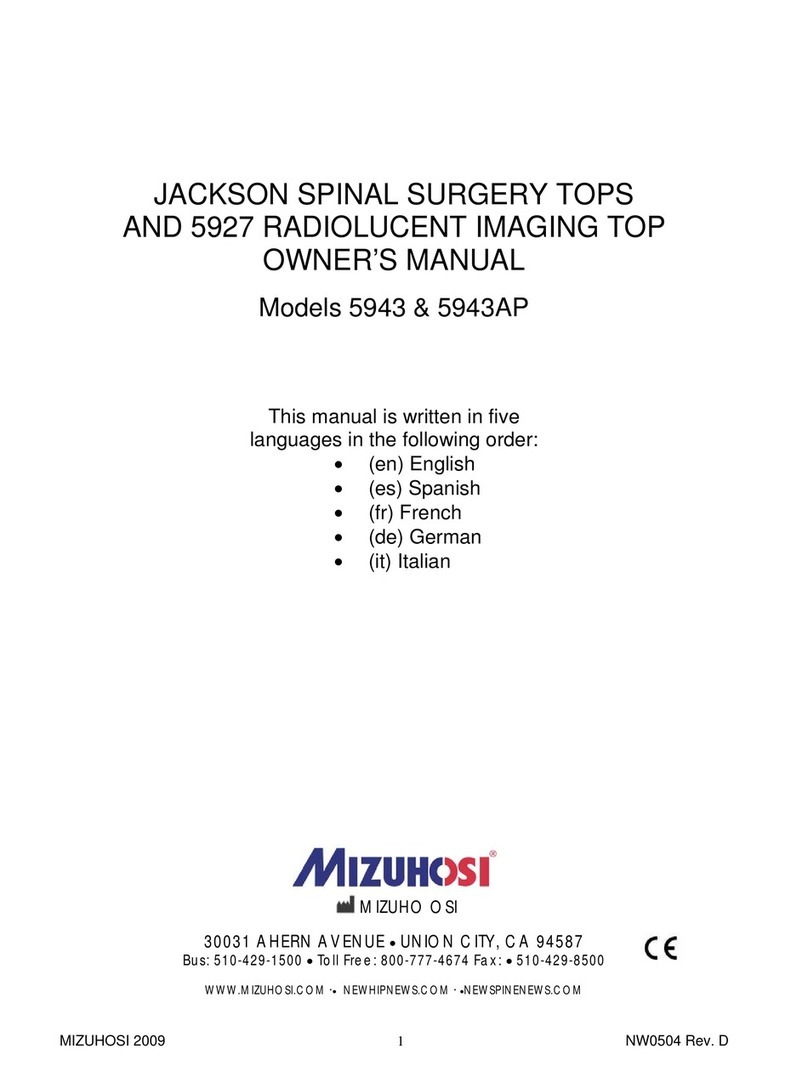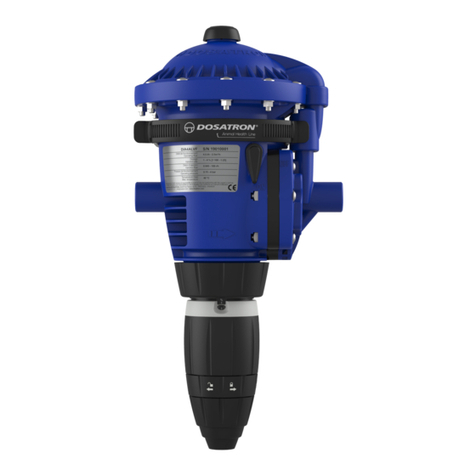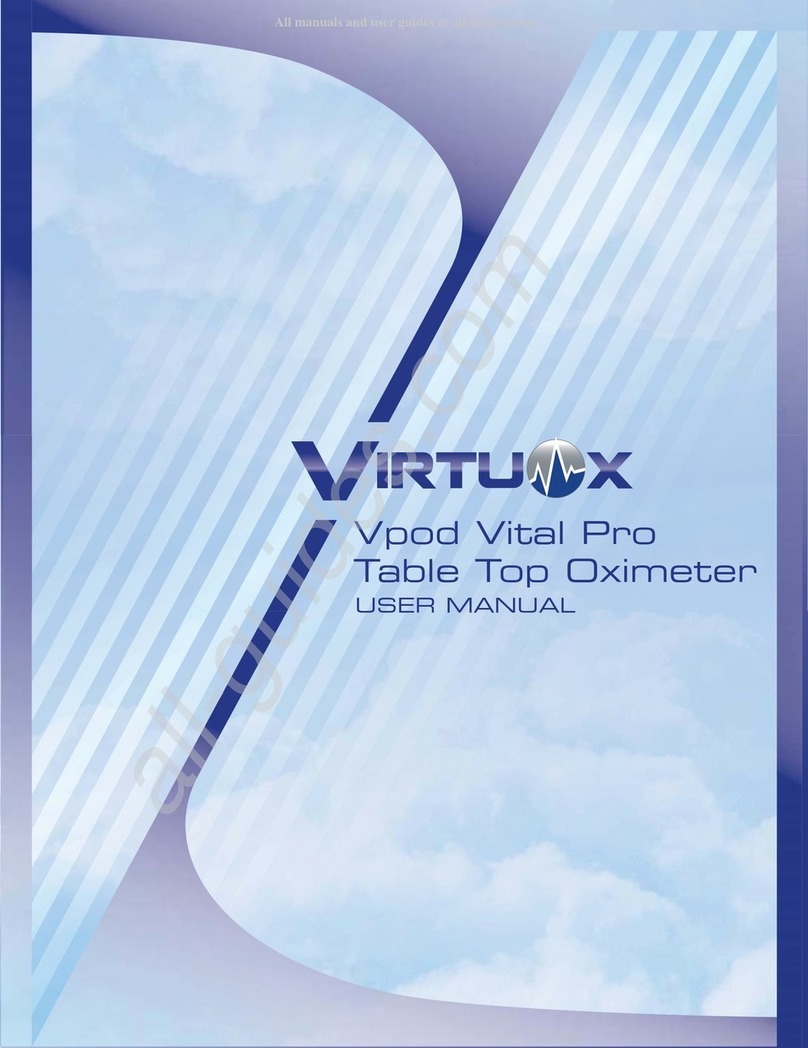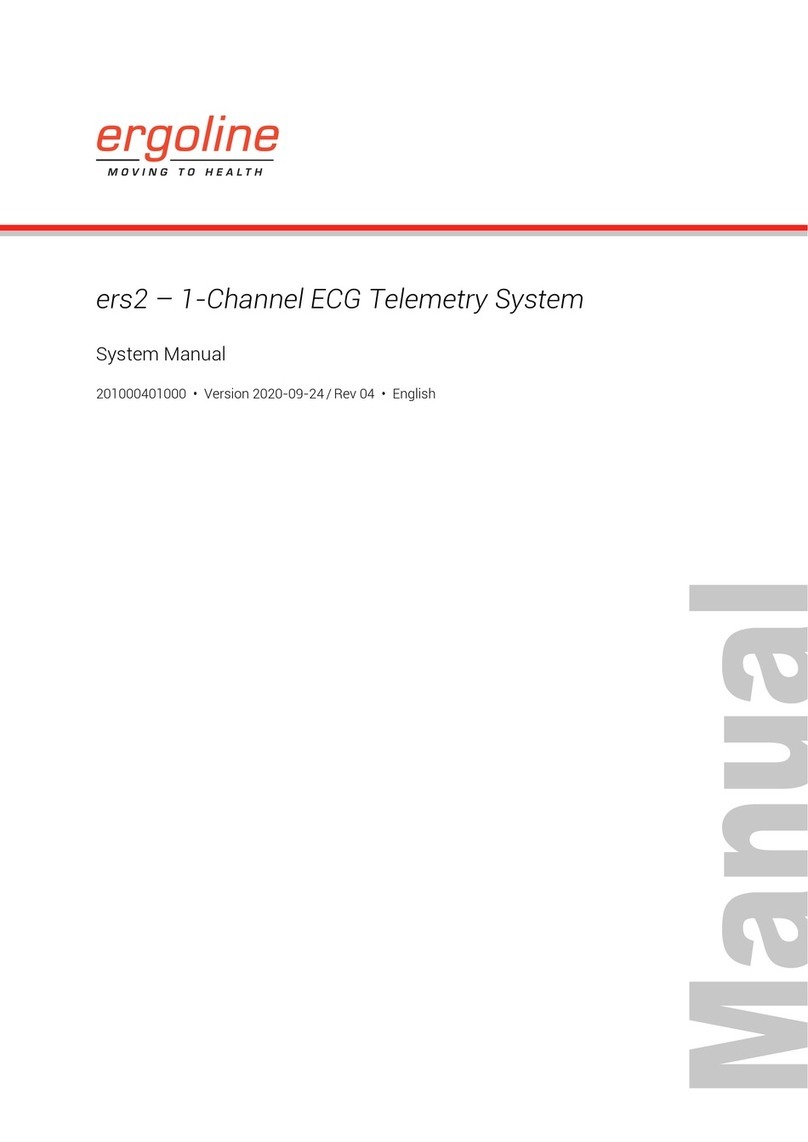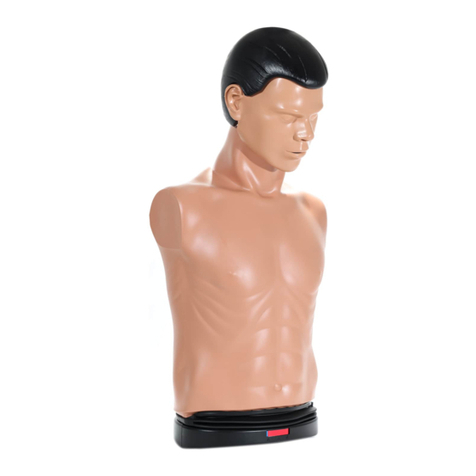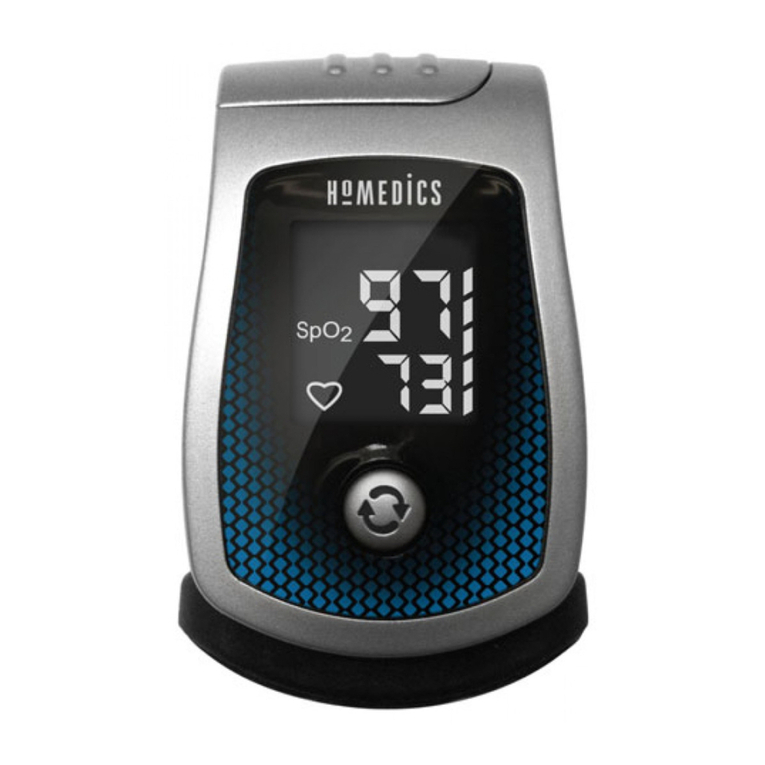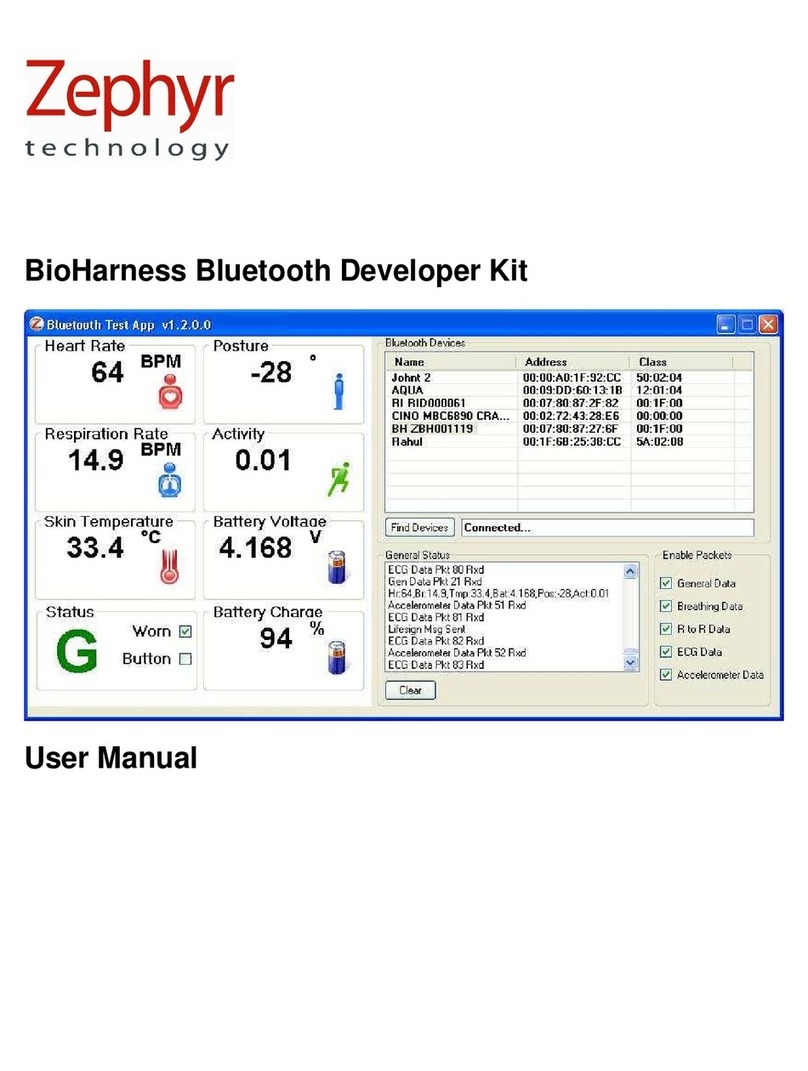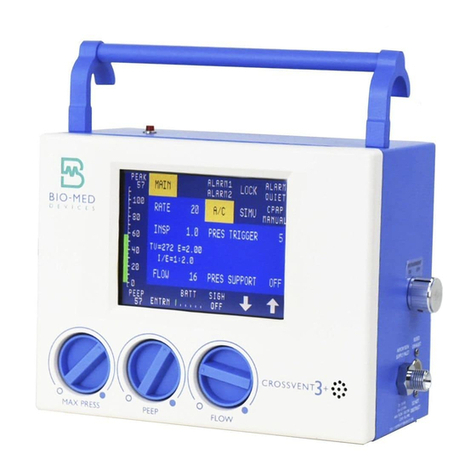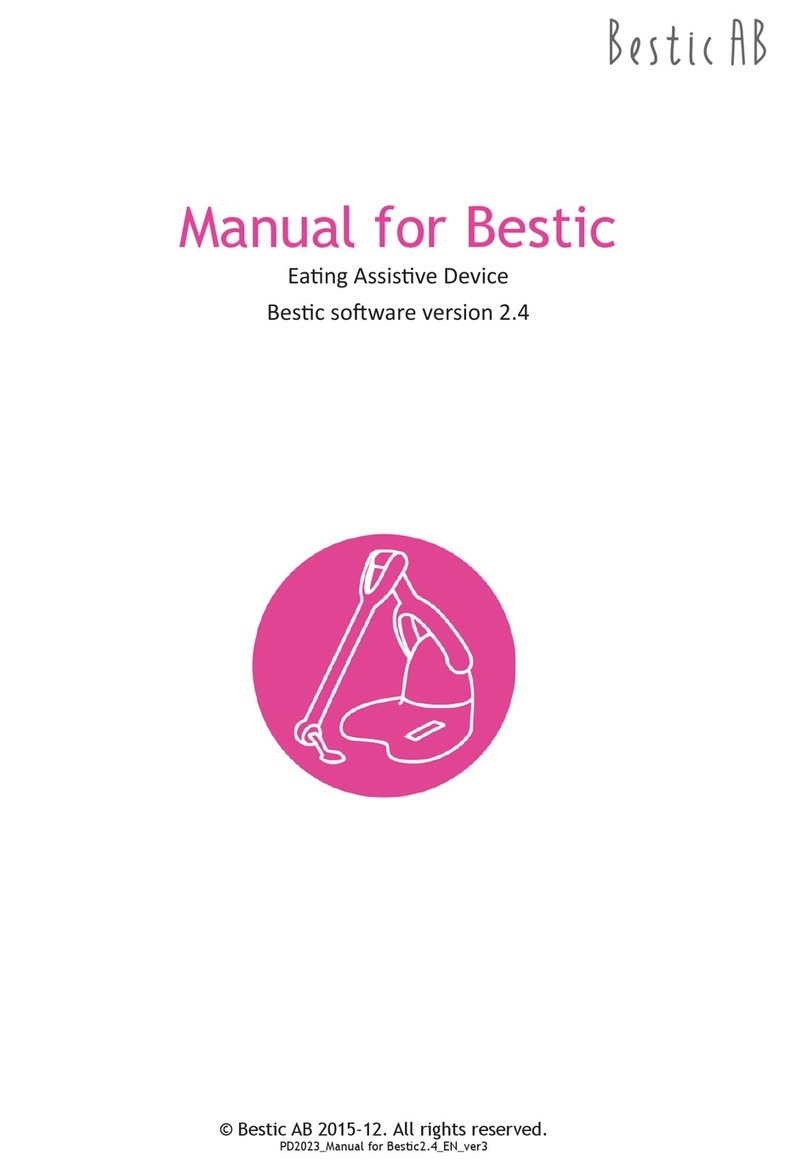Mediana hearton aed a10 User manual

OPERATOR’S MANUAL
HeartOn A15®
Automated External Defibrillator
www.medianadefib.co.uk
Distributed by:
Reliance Medical Limited
Congleton, Cheshire CW12 4XP
Part Number-Revision: A7300-0
Revised Date: 0613
Copyright © 2013 All rights reserved.
OPERATOR’S MANUAL
HeartOn A10®
Automated External Defibrillator
MEDIANA
HEARTON
AED A10

Directive
Copyright law allows no part of this instruction manual to be reproduced without
permission.
The contents of this manual are subject to change without notice.
The contents of this manual should be correct. If, for some reason, there are any
questionable points, please do not hesitate to contact our service center.
The manual will be replaced if any pages are missing or collation is incorrect.
Warranty
Device failure or damage related to the following situations during the guarantee period
is not covered by this warranty:
Installation, transfer installation, maintenance and repairs by any person other than
an authorized Mediana. employee or technician specified by Mediana.
Damage sustained to the Mediana product(s) caused by product(s) from another
company excluding products delivered by Mediana.
Damage – caused by mishandling and/or misuse – is the responsibility of the user.
Maintenance and repairs utilizing maintenance components that are not specified
by Mediana.
Device modifications or use of accessories not recommended by Mediana.
Damage caused by accidents or natural disasters (earthquakes, flooding, etc.).
Damage resulting from usage where caution statements and operating instructions
shown in this manual have not been followed.
Damage due to neglect of specified maintenance checks.
This warranty only covers the hardware of the HeartOn A10. The warranty does not
cover the following selections:
Whatever damage or loss results from the attachment of accessories or their
operation.
In the event of a defect in the product, contact our sales outlet or EU representative
as noted on the back cover.
The HeartOn A10 conforms to the EMC standard IEC60601-1-2.
Note: It is possible that using in the vicinity of mobile phone may result in disruption in
the AED operation.
Revision History
The documentation part number and revision number indicate its current edition. The revision
number changes when a new edition is printed in accordance with the revision history of the
documentation. Minor corrections and updates which are incorporated at reprint do not cause
the revision number to change. The document part number changes when extensive
technical changes are incorporated.
Trademark
Product brand names shown in this manual are likely to be the trademark or registered
trademark of the company concerned.

i
CONTENTS
CONTENTS....................................................................................................................................................i
SAFETY INFORMATION..............................................................................................................................1
General Safety Information ...................................................................................................................1
Warning .................................................................................................................................................1
Cautions ................................................................................................................................................3
INTRODUCTION...........................................................................................................................................5
Intended Use for the AED......................................................................................................................5
About This Manual.................................................................................................................................5
Training..................................................................................................................................................6
Training..................................................................................................................................................6
DESCRIPTION OF THE AED.......................................................................................................................7
Top and Right Panel Components.........................................................................................................7
Bottom Panel Components ...................................................................................................................8
Rear Panel Components .......................................................................................................................8
Symbols and Labels ..............................................................................................................................9
SETTING UP THE AED ..............................................................................................................................11
Unpacking and Inspection ................................................................................................................... 11
List of Components.............................................................................................................................. 11
Soft Carry Case ...................................................................................................................................12
SD card................................................................................................................................................12
IrDA port ..............................................................................................................................................12
Setting up the AED ..............................................................................................................................13
BATTERY OPERATION..............................................................................................................................15
Operating the AED on Battery Power..................................................................................................15
Battery Status Indication......................................................................................................................16
Self Test ...............................................................................................................................................17
USING THE AED ........................................................................................................................................19
2010 AHA Guidelines for CPR and ECC.............................................................................................19
Major changes in the 2010 AHA Guidelines for CPR and ECC ..........................................................19
2010 CPR GUIDELINES .....................................................................................................................20
Pre Defibrillation Action .......................................................................................................................20
Operating the AED...............................................................................................................................21
AHA 2010 configuration.......................................................................................................................25
Note Performing CPR..........................................................................................................................25
Note User and Bystander Safety.........................................................................................................26
MAINTENANCE..........................................................................................................................................27
Recycling and Disposal .......................................................................................................................28
Returning the AED and System Components .....................................................................................28
Service.................................................................................................................................................28
Periodic Safety Checks .......................................................................................................................28
Cleaning ..............................................................................................................................................29
Battery Maintenance ...........................................................................................................................29
Pads Maintenance...............................................................................................................................29
The AED Maintenance ........................................................................................................................30
TROUBLESHOOTING................................................................................................................................31
General................................................................................................................................................31
Corrective Action .................................................................................................................................31
EMI (Electromagnetic Interference).....................................................................................................32
Obtaining Technical Assistance ...........................................................................................................32
GLOSSARY.................................................................................................................................................33
SPECIFICATION.........................................................................................................................................35
Compliance..........................................................................................................................................40
Manufacturer’s Declaration .................................................................................................................43

ii
Figures
Figure 1. Top and Right Panel Components.................................................................................................7
Figure 2. Bottom Panel Components............................................................................................................8
Figure 3. Rear Panel Components................................................................................................................8
Figure 4. Battery Placement........................................................................................................................15
Figure 5. Action Icon – Step 1.....................................................................................................................22
Figure 6. Action Icon – Step 2.....................................................................................................................22
Figure 7. Action Icon – Step 3.....................................................................................................................22
Figure 8. Action Icon – Step 4.....................................................................................................................22
Figure 9. Action Icon – Step 5.....................................................................................................................23
Figure 10. Pads Placement.........................................................................................................................23
Figure 11. Action Icon – Step 6 ...................................................................................................................23
Figure 12. Action Icon – Step 7...................................................................................................................24
Figure 13. Action Icon – Step 8...................................................................................................................24
Figure 14. Use by date of Pads...................................................................................................................30
Tables
Table 1. Panel and Label Symbols................................................................................................................9
Table 2. Accessories....................................................................................................................................11
Table 3. The battery Status Icon..................................................................................................................16
Table 4. Electromagnetic Emissions (IEC60601-1-2) .................................................................................43
Table 5. Electromagnetic Immunity (IEC60601-1-2) ...................................................................................43
Table 6. Electromagnetic Immunity (IEC60601-1-2) (continued)................................................................44
Table 7. Recommended Separation Distances...........................................................................................45
Table 8. Cables (IEC60601-1-2)..................................................................................................................45

1
SAFETY INFORMATION
General Safety Information
This section contains important safety information related to general use of the HeartOn
A10®. Other important safety information appears throughout the manual. The HeartOn
A10®will be referred to as the AED throughout this manual.
Before use, carefully read operator’s manual, accessory directions for use, all
precautionary information and specifications.
Warning
Warnings are identified by the WARNING symbol shown above.
Warnings alert you to potential serious outcomes (death, injury, or adverse events)
to the patient or user.
WARNING: As a user of an AED it is essential that you inform Mediana of any
incident where your AED is suspected to have caused a death, serious injury or
illness. If you have any suspicions that this is the case inform Mediana directly or
through your authorized Mediana dealer.
WARNING: The AED must be used by a person trained in CPR and the use of
AED. The qualification for the usage of AED should follow the local laws.
WARNING: The AED has the capability to deliver therapeutic electrical shocks.
The shock can cause serious harm to either operators or bystanders. Caution
must be taken to ensure that neither the operators nor bystanders touch the when
a shock is to be delivered.
WARNING: To safeguard against interference you must operate the AED at 2
meters (6 feet) away from all RF devices and other susceptible equipment.
Alternatively switch off equipment affected by or causing Electromagnetic
Interference.
WARNING: The AED has been designed to work on unresponsive, non-breathing
and pulseless* patients. If the patient is conscious or breathing, do not use the
AED to provide treatment. (*: healthcare provider only)
WARNING: Touching the patient during the analysis phase of treatment can cause
interference with the diagnostic process. Avoid contact with the patient and keep
the patient as while ECG analysis is being carried out. The AED will instruct you
when it is safe to touch the patient.
WARNING: Always stand clear of patient when delivering treatment. Defibrillation
energy delivered to the patient may be conducted through the patient’s body and
cause a lethal chock to those touching the patient.
WARNING: It has been determined that the AED is safe to use in conjunction with
oxygen mask delivery systems. However, due to the danger of explosion it is
strongly advised that the AED should not be used in the vicinity of explosive
gases. This includes flammable anesthetics or concentrated oxygen.

2
WARNING: The Adult pads must be used on patients over 8 years old. The
Pediatric pads must be used on patients less than 8 years old or less than 25 kg
(55lb). Do not use the AED on patient less than 1 year old.
WARNING: Proper placement of the pads is critical. Strict observance of pad
positioning instructions, as indicated on the labeling and in training, is essential.
Care must be taken to ensure pads are adhered to the patients' skin properly. Air
pockets between the adhesive pad and skin must be eliminated. Failure in pad
adhesion may hinder effectiveness of therapy or cause excessive skin burns to
the patient if a shock is applied. Reddening of the skin may appear after use, this
is normal.
WARNING: The battery of AED is not rechargeable. Do not try to recharge, open,
crush, or burn the battery, or it may explode or catch fire.
WARNING: Do not allow the pads to contact other electrodes or metal parts that
are in contact with the patient.
WARNING: Avoid contact between parts of patient’s body and conductive fluids
such as gel, blood or saline and metal objects which may provide unwanted
pathways for defibrillating current.
WARNING: Do not use the AED near or within puddles of water.
WARNING: Do not reuse electrodes to many patients.
WARNING: Use the AED or accessories only as described in this manual.
Improper use of the AED can cause death or injury.
WARNING: Do not use or place the AED in service if the status indicator of AED
displays “X”.
WARNING: Keep batteries dry and away from any heat sources (including direct
sunlight). If you see any damage or leakage, do not allow the liquid to come in
contact with your skin or eyes. If contact has been made, wash the affected area
with plenty of water and seek medical advice immediately.
WARNING: The AED contains an automatic disarm of the stored energy. If the
operator has not delivered the energy to a patient, an internal timer will disarm the
stored energy. This stored electrical energy can potentially cause death or injury if
discharged improperly. Follow all instructions in this manual.

3
Cautions
Cautions are identified by the CAUTION symbol shown above.
Caution statements identify conditions or practices that could result in damage to
the equipment or other property.
CAUTION: The AED may not operate properly if it is operated or stored at
conditions outside the ranges stated in this manual.
CAUTION: The AED was designed to be sturdy and reliable for many different use
conditions. However, handling the AED too roughly can damage it or its
accessories and will invalidate the warranty. Check the AED and accessories
regularly for damage, according to directions.
CAUTION: Before delivering a shock, it is important to disconnect the patient from
non-defibrillation protected electronic devices, such as blood-flow meters, that may
not incorporate defibrillation protection. In addition, make sure the pads are not in
contact with metal objects such as a bed frame or stretcher.
CAUTION: The pads pouch shall not be opened until immediately prior to use.
CAUTION: Do not use or place the AED in service until you have read the AED
Operator’s manual.
CAUTION: Do not use or stack the AED with other equipment. If the AED is used or
stacked with other equipment, verify proper operation prior to use.
CAUTION: Handling or transporting the patient during ECG analysis can cause
incorrect or delayed diagnosis.
CAUTION: Periodic checks of this AED must be undertaken to ensure among other
things that the AED is not damaged in any way.
CAUTION: The pads are a single use item and must be replaced after each use or if
pouch that seals pads has been broken/compromised in any way. If damage is
suspected the pads must be replaced immediately.
CAUTION: Do not use training pads with this AED.
CAUTION: Carefully observe pacemaker patients. Patient history and physical
examination are important in determining the presence of implanted pacemaker.
Patient pacemakers may reduce the sensitivity of the AED analysis and errors in
detecting shockable rhythms.
CAUTION: If the pads are attached to the chest firmly, the AED can analyze the
exact ECG and prevent the skin burns. But if the pads are overlapped on the patient
chest, the pads will not deliver defibrillation energy properly.

4
This page is intentionally left blank.

5
INTRODUCTION
Mediana provides you with a fully configurable AED system to allow you to comply with
your chosen SCA treatment protocol. Our current AED is configured to be compliant with
the 2010 version of the AHA/ERC guidelines on Cardiopulmonary Resuscitation (CPR)
and Emergency Cardiovascular Care (ECC). You should have been trained in the
appropriate version of the AHA/ERC guidelines and the use of your AED configuration.
Contact Mediana or your authorized Mediana distributor for further information.
Intended Use for the AED
The AED is intended to be used to treat someone who is unresponsive, non-breathing
and pulseless for the adult and pediatric in all area of a hospital, pre-hospital, public
access, alternate care and home healthcare environment. AED users should be skilled at
level of a doctor, nurse, medical specialist or trained user.
Note: Hospital use typically includes areas such as general care floors, operating rooms,
special procedure areas, intensive and critical care areas within the hospital.
Hospital-type facilities include physician office-based facilities, sleep labs, skilled
nursing facilities, surgical centers, and sub-acute care centers.
Note: The intended patient populations are adult and pediatric (1-8 years old or less than
25 kg (55lb)) can be treated with the appropriate pads.
Note: The AED is intended for trained user who knows how to use the AED. Potential user
should be trained in cardiopulmonary resuscitation (CPR), the use of the AED.
Many training institutes have courses that combine performing CPR and using the
AED. The training course can be accomplished for various durations, but crash
course/most basic course can be accomplished in one day. For further information
on training course, contact your local authorized supplier or Mediana technical
support.
About This Manual
This manual explains how to set up and use the AED.
Read the entire manual including the Safety Information section, before you operate the
AED.

6
Training
SCA is a condition requiring immediate emergency medical intervention. This intervention,
due to the nature of the condition, can be performed prior to seeking the advice of a
physician. In order to properly diagnose this condition Mediana recommends that all
potential users of the AED as a minimum, are fully trained in cardiopulmonary
resuscitation (CPR), the use of the AED, specifically the AED. It is also recommended that
this training be kept up to date by means of regular refresher courses and when
recommended by your training provider. If potential users of the AED are not trained in
these techniques contact your Mediana dealer or Mediana directly either of whom can
arrange for training to be provided. Alternatively contact your local government health
department for information on certified training organizations in your region.
Note: There is limited published data on AED used by minimally trained rescuers in the
home. It is not clear what safety issues may occur from AED use in such an
environment.
Features for the AED
Physical/Mechanical
The AED is an automated external defibrillator (AED) used for the fast delivery of
defibrillation electric shock therapy which can be battery-operated.
Electrical
The AED has an internal battery which is the non-rechargeable battery.
Display
The indication is LED indicator that flashes red LED under the relevant action icon.
Auxiliary Input/Output(s)
The AED provides Infrared communication port, SD card ports.

7
DESCRIPTION OF THE AED
Top and Right Panel Components
Figure 1. Top and Right Panel Components
1 Cover Cover shields the LED indicator, the power on/off button, the
speaker, the shock button.
2 Status indicator Status indicator displays the unit status and the battery status.
3 Pad connector Pad connector links the pads.
4 LED indicator LED indicator flashes red LED under the relevant action icon.
5 Power on/off button Power on/off button turns on/off the AED.
6 Speaker Speaker is acoustic indicator for guidance.
7 Push button Push button opens the cover.
8 Shock button Shock button delivers the shock.
9 SD card port SD card is used to save the data and update the AED firmware.
10 Infrared
communication port Infrared communication port is used to communicate with the PC.
1
2
3
4
5
6
7
8
10
9

8
Bottom Panel Components
1. Battery pack
Figure 2. Bottom Panel Components
Rear Panel Components
1. Handle
Figure 3. Rear Panel Components
1
1

9
Symbols and Labels
The following symbols may be used in this manual, related documentation, or appear on
system components or packaging.
Table 1. Panel and Label Symbols
Symbols Description Symbols Description
Ready to use
CE mark
Not ready to use Caution
Battery capacity Follow instructions for use
Contains no latex
Environmental
shipping/storage
altitude limitations
Use by date
Environmental
shipping/storage
humidity limitations
EU representative
Environmental
shipping/storage
temperature limitations
Manufacturer
Fragile-handle with care
Date of manufacture
This way up
Reference number
Keep dry
Serial number
Type CF – Defibrillator
proof
Single patient use only Dust and water resistance
Disposal instructions
UL mark

10
This page is intentionally left blank.

11
SETTING UP THE AED
WARNING: To ensure accurate performance and prevent AED failure, do not
expose the AED to extreme moisture, including direct exposure to rain. Such
exposure may cause inaccurate performance or AED failure. Refer to Specification
section.
WARNING: Using damaged or expired AED or accessories may cause the AED to
perform improperly, and/or injury the patient or the user.
Unpacking and Inspection
The AED is shipped in one carton. Examine the AED including the accessories carefully
for evidence of damage. Do not use damaged equipment. Refer to the Maintenance
section for instructions on returning damaged items. Ensure all potential users are
suitably trained.
Note: Inspect the packaging of accessories to ensure integrity of seals and validity of use
by date.
List of Components
The following items are accessories in the package. Optional accessories may be
ordered if needed. Contact qualified service personnel or your local supplier for pricing
and ordering information.
Table 2. Accessories
Standard Accessories Qty
HeartOn A10
®
1
Operator’s manual1
Adult Pads (1.7m)1
Non-rechargeable LiMnO2Battery (15V, 4200mAh) 1
Soft Carry Case 1
Optional Accessories Qty
Pediatric Pads (1.7m) -
SD card (2Gbyte) -
HeartOn A10 Event Review Software -
HeartOn A10 Event Review Software - User Guide -
Infrared communication adaptor -
Recommended Accessories Qty
Scissors – for cutting the victim’s clothed if needed -
Disposable gloves – to protect the user -
A disposable razor – to shave the chest if hair prevents good pads contact -
A pocket mask or face shield – to protect the user -
A towel or absorbent wipes – to dry the victim’s skin for good pads contact -

12
Soft Carry Case
WARNING: The AED should not be used on someone who is responsive when
shaken or breathing normally.
The soft carry case has been designed to allow the AED not to move in the soft carry
case by using the AED’s own handle. The user can check the status indicator of AED
without having to open the carry case. The paper with contact information of the nearest
emergency medical services can be inserted to the clear cover. The soft carry case has
the pocket on the rear side of the carry case for the manual and spare pads. Other two
pockets on the right and left side of the carry case are used for spare battery.
SD card
The SD card is inserted into the SD card port on the AED’s right panel as described
below. The SD card is used to record the history of the AED performance and to update
the AED firmware. The recorded history in the SD card can be checked by the HeartOn
A10 Event Review Software. If you want to use the SD card to use the HeartOn A10
Event Review Software or to update the AED firmware, please contact qualified service
personnel or your local supplier.
1. When the AED is turned on, turn off the AED by pressing the Power on/off button.
2. Open the SD card port cover.
3. Insert the SD card into the SD card port.
4. Close the SD card port cover.
5. Turn on the AED by pressing the Power on/off button.
6. After complete the update, automatically turn off itself.
Infrared communication port
Infrared communication port provides wireless communications from the AED to a PC
through the Infrared communication data download cable and DC adaptor which is
connected to PC. The Infrared communication is used to update the AED firmware and to
transfer information and to connect to service mode. If you want to use Infrared
communication port, please contact qualified service personnel or your local supplier.

13
Setting up the AED
WARNING: Use only Mediana-approved and specified parts, accessories, optional
parts, consumables, and components. Use of unauthorized accessories may
cause the device to operate improperly and provide false measurements. Follow
all labeling instructions on the defibrillation pads and the battery.
WARNING: Always follow your facility’s infection control procedures and
applicable regulations when disposing of anything that has been used on patients.
CAUTION: Do not open the pads from packaging previously until the time of
emergency use when pads are used for patient.
Install 1 1. Remove defibrillation pads from its packaging.
2. To open the cover, press the Push button.
3. Plug in defibrillation pads.
Note: When pads are already connected to the AED in packaging, take out the AED from
the packaging and then move to Install 2.
Note: Do not open defibrillation pads protective packaging until the time of emergency use
when they are applied to a patient.
Note: To prepare of an emergency, pads must be pre-attached to the AED and keep the
pads cable connected to the AED at all times.
Install 2
Check that the AED is working optimally.
1. Push the Power on/off button.
2. Ensure that you can hear the voice prompts:
“Unit ok”
“Adult pads” or “Pediatric pads”
3. Ensure you can see the status indicator display “O”.
4. Turn off the AED by pushing the Power on/off button.
5. Close the Cover with placing the defibrillation pads inside the AED.
Install 3
Place the AED into its Soft Carry Case.
Install 4
Put into a storage or safe visible location.
The AED should be kept in a convenient central area. Place it near a telephone so that
the rescuer can call Emergency Medical Services and retrieve the AED without wasting
time. Some important points to remember when storing:
Store the AED in a suitable location for easy access.
Do not lock the location where AED is being placed.
Store the AED in a clean and dry environment.
Install the AED in the environmental operation condition described in this manual.
Make all necessary arrangements to ensure that the AED is accessible at all times.
Inform any possible users of the location of the AED.
Note: Storage differs in some countries. Ask qualified service personnel or your local
supplier.

14
This page is intentionally left blank.

15
BATTERY OPERATION
WARNING: Test battery regularly, when the voltage of battery is very low. A
battery that does not pass its test might shut down expectedly.
WARNING: Do not use a battery that is damaged, leaking, or wet.
WARNING: Do not use or store the battery in a place that may be exposed to high
temperature.
CAUTION: To ensure the availability of adequate power during an emergency,
keep a fully charged spare battery pack with the AED at all times.
CAUTION: When the voltage of the battery is very low, it is a possibility of not
operating.
CAUTION: If the battery shows any signs of damage, leakage or cracking, it must
be replaced immediately.
CAUTION: Discarded batteries may explode during incineration. Dispose used
batteries properly. Do not dispose of batteries in refuse containers.
CAUTION: Check battery capacity regularly. Replace the new battery if you need.
CAUTION: Except for inspection, if the AED is frequently turned on, turned off or
discharged, battery standby life will not last longer than the intended standby life
by manufacturer.
Operating the AED on Battery Power
The AED has an internal non-rechargeable battery. The battery status icon appears on
the Status indicator when the AED is on battery power.
Figure 4. Battery Placement

16
Replacing the battery
1. Turn off the AED.
2. Push the hole on the left side using the small regular (-) screwdriver.
3. Carefully remove the battery pack.
4. Insert the new battery pack carefully.
The AED uses the non-rechargeable battery. Used battery is changed to new battery.
Before turning on the AED with a battery that has been completely discharged, first
replace the battery. The AED may then be powered on.
Battery Status Indication
A new battery’s life time is as below;
- Shelf life (in the original packaging): 2 years from manufacture date when stored and
maintained according to direction provided in the operator’s manual.
- Standby life (inserted in the AED): 5 years from manufacture date when stored and
maintained according to direction provided in the operator’s manual.
- Discharge: A minimum of 200 shocks (excepting the CPR period between the
defibrillation therapies) or 10 hours of operating time under the ambient temperature at
20°C.
Mediana recommends that although the battery is used only one time, used battery is
changed to new battery.
Note: After 200 times of shock, the voice prompt “Low battery, replace new battery” will be
emitted.
Note: Due to the physical dimensions of the battery compartment, only batteries supplied
by Mediana should be used. Using other types of replacement batteries may result
in damage to the AED and void the limited warranty.
When operating on batteries, the battery status icon in the status indicator indicates the
battery condition. See Table 3.
Table 3. The Battery Status Icon
Battery Status Icons Battery Status
full charged
(≤200 shocks or 10 hours of
operating time)
used
used (≤9 shocks)
discharged (no shock)
If you hear the voice prompt “low battery, replace new battery” when the AED is turned on
or is being used, the AED would be available 9 shocks. If the last bar of the battery
indicator is invisible, buzzer would be sounded 2 times and then turned off automatically.
Table of contents
Other Mediana Medical Equipment manuals
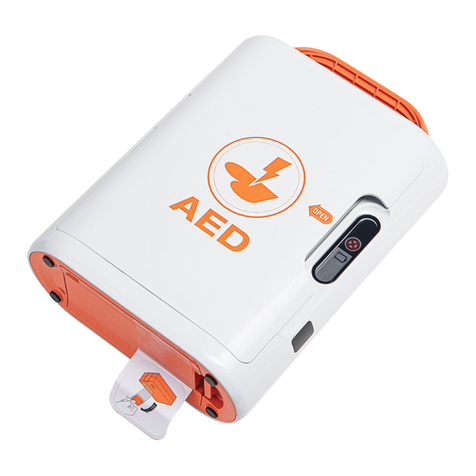
Mediana
Mediana AED A16 User manual
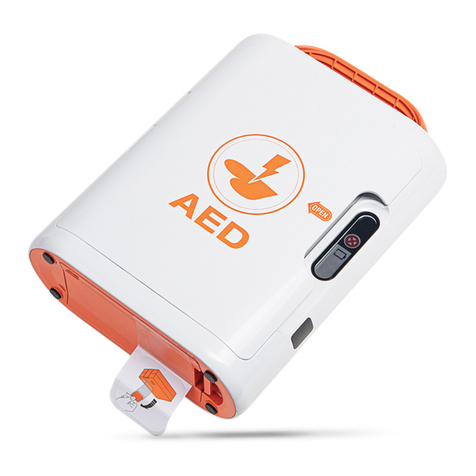
Mediana
Mediana HeartOn A16 Series User manual
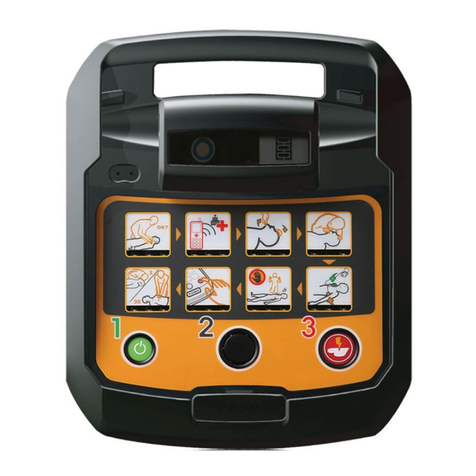
Mediana
Mediana RESCATE PERU Heart On AED A10 User manual
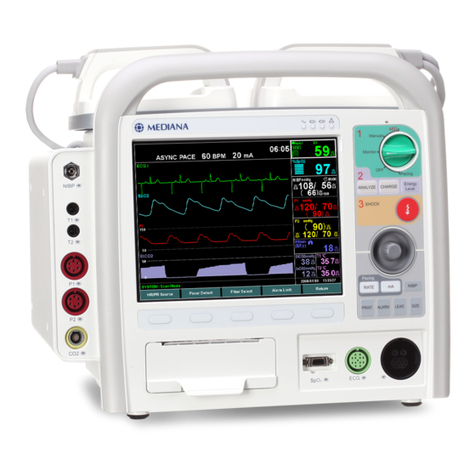
Mediana
Mediana D500 User manual
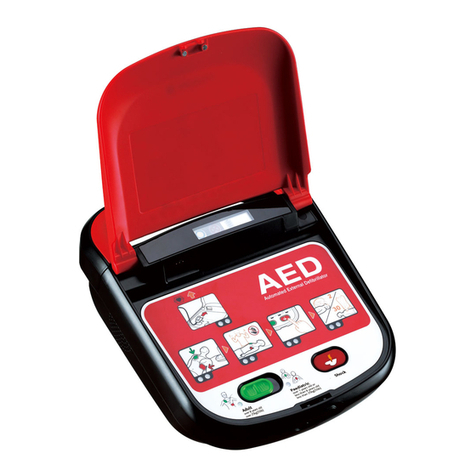
Mediana
Mediana HeartOn A15 User manual
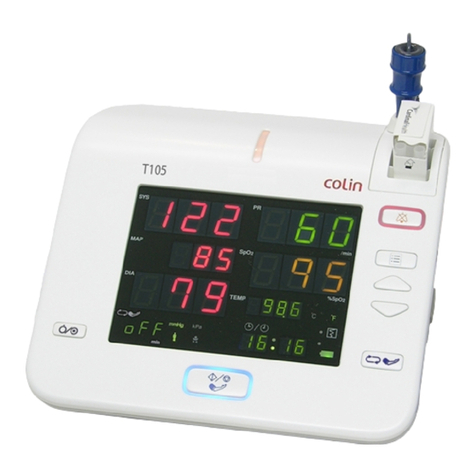
Mediana
Mediana HBP-T105 Series User manual
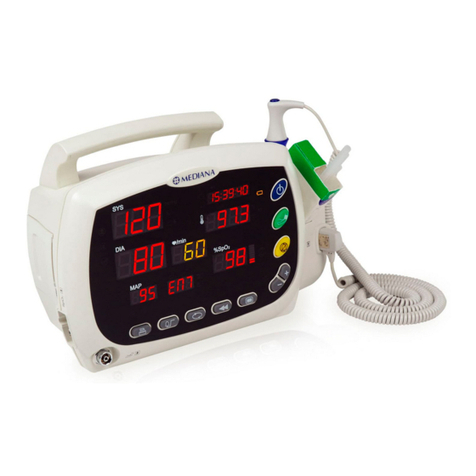
Mediana
Mediana YM1000 User manual
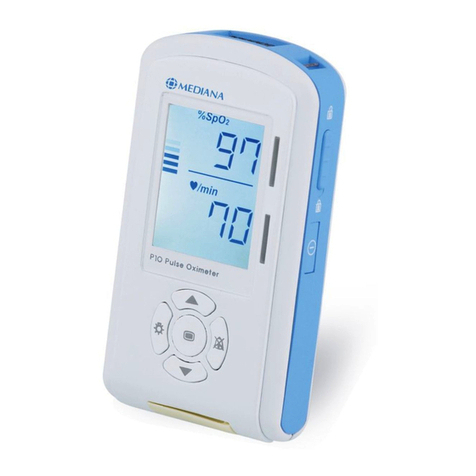
Mediana
Mediana P10 User manual

Mediana
Mediana D500 User manual
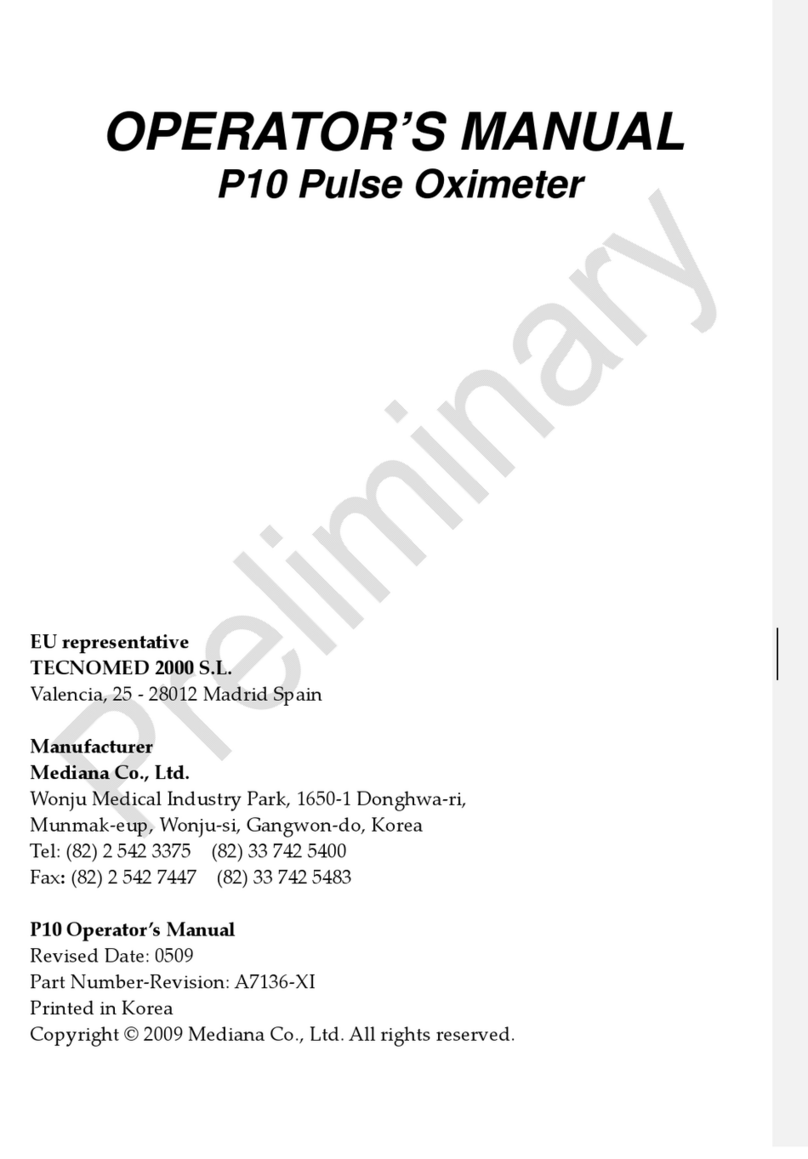
Mediana
Mediana P10 User manual
